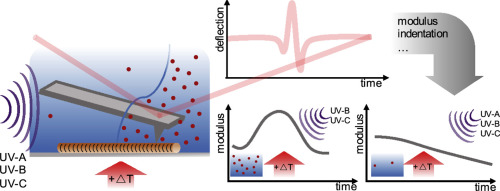Journal of the Mechanical Behavior of Biomedical Materials ( IF 3.3 ) Pub Date : 2018-08-30 , DOI: 10.1016/j.jmbbm.2018.08.039 Marcus Schulze , Melanie Rogge , Robert W. Stark

|
Collagen plays a decisive role as a functional substrate in tissue engineering. In particular, the rigidity of the collagen influences the behaviour of the attached cells. Thus, modification and controlled adjustment of collagen's characteristics are essential. To this end, controlled exposure to ultraviolet (UV) light is a promising process because it can be temporally and spatially well defined. In this study, we investigated the effect of UV exposure on surface supported single collagen fibrils in situ. This procedure allowed for a direct comparison between the untreated and modified states of type I collagen. Atomic force microscopy was used to map the mechanical properties. Exposure to UV light was used to influence the mechanical properties of the fibrils in varied liquid environments (deionized water and phosphate-buffered saline (PBS)). The results led to the assumption that combined UV/thermal treatment in deionized water continuously lowers the elastic modulus. In contrast, experiments performed in PBS-based solutions in combination with UV-B and UV-C light or thermal treatment up to 45 °C suggested an increase in the modulus within the first 30–40 min that subsequently decreased again. Thus, the wavelength, exposure, temperature, and chemical environment are relevant parameters that need to be controlled when modifying collagen using UV light.
中文翻译:

原子力显微镜测量在紫外光的影响下探测单个胶原原纤维的机械性能
胶原蛋白在组织工程中作为功能性底物起着决定性的作用。特别地,胶原蛋白的刚度影响附着细胞的行为。因此,胶原蛋白特性的修饰和受控调节是必不可少的。为此,受控地暴露于紫外线(UV)是一个有前途的过程,因为可以在时间和空间上对其进行很好的定义。在这项研究中,我们调查了紫外线对原位表面支撑的单个胶原纤维的影响。该程序允许直接比较I型胶原的未处理状态和修饰状态。原子力显微镜用于绘制机械性能图。在不同的液体环境(去离子水和磷酸盐缓冲盐水(PBS))中,暴露于紫外线下会影响原纤维的机械性能。结果得出这样的假设,即在去离子水中联合进行紫外线/热处理会不断降低弹性模量。相比之下,在基于PBS的溶液中结合UV-B和UV-C光或最高45°C的热处理进行的实验表明,在最初的30-40分钟内模量有所增加,随后又有所下降。因此,波长,曝光,温度和化学环境是在使用紫外线修饰胶原蛋白时需要控制的相关参数。在基于PBS的溶液中结合UV-B和UV-C光或在最高45°C的温度下进行的实验表明,在最初的30-40分钟内模量有所增加,随后又有所下降。因此,波长,曝光,温度和化学环境是在使用紫外线修饰胶原蛋白时需要控制的相关参数。在基于PBS的溶液中结合UV-B和UV-C光或在最高45°C的温度下进行的实验表明,在最初的30-40分钟内模量有所增加,随后又有所下降。因此,波长,曝光,温度和化学环境是在使用紫外线修饰胶原蛋白时需要控制的相关参数。











































 京公网安备 11010802027423号
京公网安备 11010802027423号